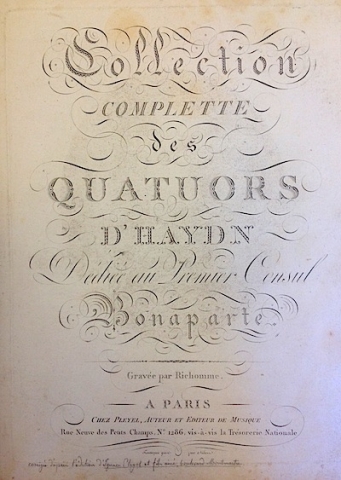Topics

Collection complette des quatuors / d'Haydn ; dédiée au Premier Consul Bonaparte
A Paris : Chez Pleyel, auteur et editeur de musique, [1802]
Stanford University Libraries, Memorial Library of Music, MLM 496
Link to downloadable images of this work:
violin I | violin II | viola | basso
Goethe described the classical string quartet form as “four rational people conversing,” a type of discourse embodied in the quartets of Haydn, Mozart, Beethoven, and Schubert. Haydn, perhaps more than any of his contemporaries, shaped the string quartet into the form we know today, moving away from the typical divertimenti solo with accompaniment, to four equal voices working out thematic material in (often lively) conversation. The complete set of parts featured here is a variant of the first edition of Haydn’s complete string quartets, dedicated to Napoleon Bonaparte, and known as the “Bonaparte Edition,” published by Maison Pleyel in Paris in 1803.
Composer, conductor, and publisher Ignace Pleyel (1757-1831) studied with Haydn at Eisenstadt for five years beginning in 1772, around the time Haydn composed his seminal op. 20 quartets. (Incidentally, few autograph manuscripts of the string quartets exist today; the autograph manuscript of the op. 20 quartets was once owned by Johannes Brahms, who then donated them to the Gesellschaft der Musikfreunde Wien, where they reside today).
In 1795 Pleyel established Maison Pleyel in Paris and published works by Haydn, Clementi, Dussek, Beethoven, Boccherini, and others. In 1815 Pleyel and his son Camille founded Pleyel et Cie, which produced fine pianos and harps for two centuries, ceasing production only recently, in November 2013.
Haydn’s approval of the Bonaparte Edition has clouded the debate surrounding the chronology and authenticity of the 83 quartets included therein. The New Grove entry for Haydn lists 68 authenticated quartets and a number of doubtful and spurious works. Haydn wrote to Pleyel from Vienna, Dec. 6, 1802:
“Incidentally, I am much obliged to you for the exceptionally beautiful edition of the Quartets which you sent by Herr Pichl: because of their beautiful engraving, the paper – and the fact that they are so correct – as well as their general appearance, you will be remembered for them forever.”
Each volume includes the fanciful title page engraved by Aubert and bears the dedication to Bonaparte. The music plates were engraved by Antoine-Jacques Richomme, who engraved other significant French publications including the 1781 edition of Rousseau’s Les consolations des misères de ma vie.
The first volume (violin I) lists subscribers, with over 250 names in 48 cities, including Paris, Copenhagen, St. Petersburg, Brussels, Berlin, Turin, and Madrid. Notable musicians on the list are Luigi Cherubini, André Grétry, Rudolphe Kreutzer, Etienne Méhul, Pierre Rode, Muzio Clementi, Jan Dussek, Giovanni Battista Viotti, and Luigi Boccherini. The aristocracy is also well represented by members of the Hapsburg royal family, Prince Lobkowitz, Prince von Thurn und Taxis, and the counts Razumovsky, Esterházy, and Erdődy.
The table of contents, in the form of a catalogue thématique, provides a sample of Richomme’s and Pleyel’s skills at engraving and printing music in miniature. Pleyel introduced the concept of the miniature score with publication of four Haydn symphonies in 1802.
The frontispiece is an engraved portrait of Haydn, by Jean Urbain Guérin (1760-1836).
The Bonaparte Edition at Stanford is one of only four copies in the United States. It is the third variant of the original, to which quartet no. 83 was added. It was published between 1803 and 1806.

Joseph Haydn, by Jean Urbain Guérin

Title page of the Collection complette des quatuors d'Haydn
With thanks to Astrid Smith, Rare Book and Special Collections Digitization Specialist, and the Digital Production Group for providing downloadable images of the complete work.


 Stanford University Home
Stanford University Home
Add comment